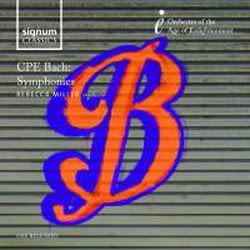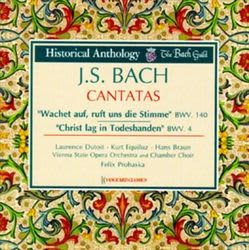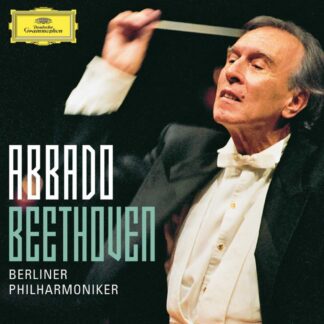Περιγραφή
Καλλιτέχνες
|
Avant garde. Eccentric. A maniac. Wild and adventurous. Off the wall. Extraordinary. No marketing hyperbole – this is how the players of the Orchestra of the Age of Enlightenment describe Carl Philip Emmanuel Bach and his music. One of the many children of JS Bach, CPE Bach always lived in his father’s shadow, and now is an almost unknown figure at least beyond the classical cogniscenti. How can such an unknown be considered a gamechanger? A listen to his music reveals just why – it constantly shifts, wrongfooting the listener when they least expect it with wild changes of direction and colour – it is bright, effervescent, and is a fascinating link between the music of his father (and the Baroque era) and Joseph Haydn (and the Classical era). CPE Bach’s orchestral works surprise and shock with their stormy expressivity, lurching key changes, dramatic shifts and febrile energy. Daring and innovarive first movements conrast with wistful slow movements and playful, dancing finales. Bach’s patron commisioned him to write the string symphonies Wq 182 ‘without regard to the difficulties of execution’, and the music scales the heightsc and plumbs the depths of both emotion and technique. The later symphonies, Wq 183, are boldly painted with a colourful orchestral palette, obbligato wind instruments highlighring the composer’s peppery sonorities and chromaticisms. In these live performances given at London’s Queen Elizabeth Hall, Rebecca Miller draws assured and ebullient playing from the OAE. Tempo are well-judged for the acoustic and, though Miller exploits a wide dynamic range, she never overplays the music’s inherent drama. The orchestral sound is rich and suave, ensemble and intonation are polished – even, perhaps, rather too refined for these Sturm and Drang works. For a grittier and more incisive approach, consider Gustav Leonhardt’s still fresh-sounding recording of select symphonies with the same orchestra of 15 years ago. Performance and Recording Kate Bolton, BBC Music Magazine Simon Thompson welcomed this release as an introduction to C.P.E. Bach’s symphonies, and it is indeed more of a mixed bag when compared to that from the Ostrobothnian Chamber Orchestra conducted by Sakari Oramo on the Alba label (review) which deals with the Wq 182 works in an orderly fashion. This is a live recording, and has plenty of that verve and energy you would want from such an experience. Audience noise is as good as absent and the recording quality is excellent, with rich bass, striking dynamic detail and plenty of stereo width. The blurb for this release would have us believe C.P.E. Bach is “an almost unknown figure … [a] forgotten pioneer.” I think this takes things a bit too far, but I do agree that these amazing orchestral works deserve to be better known. Just those stark repeated notes in the opening Allegro di molto of Wq 183/1 are enough to make you sit up and pay attention. As the music is thrown around the orchestra, changing direction like a switchback and delivering utmost excitement you begin to wonder where this music has been all your life. The sparsity of notes and extremes of register – bass and flutes in duet – are another feature in the Largo which follows. Then again there are those strange little vanishing melodies which interrupt the horn-pepped final Presto and those accompaniment arpeggios which leap out and take on a bizarre melodic function. These are all highly surprising elements, and each of these symphonies has their own shockers to entertain us from start to finish. Of the alternative recordings of C.P.E. Bach symphonies around it is worth looking out for the Academy of Ancient Music on the L’Oiseau Lyre or the English Concert with Trevor Pinnock on Archiv. Hartmut Haenchen on the Capriccio or Phoenix Edition labels is nice but more relaxed and less exciting than Rebecca Miller. Solamente Naturali on Brilliant Classics is dryly recorded and a bit ragged around the edges, so less of a contender. Comparing Wq 182/4 with the Ostrobothian Chamber Orchestra on Alba mentioned in paragraph one and there isn’t much to choose between the performances. Sakari Oramo injects more speed and perhaps more energy into the outer movements but pays the price here in there in terms of clarity. There are others with varying degrees of overlap, but by any standard these performances from the OAE are the equal of many and superior to most, and worth having in any collection. This is the kind of CD to put on loud in your car with your windows down. Heads will turn. ‘Not all orchestras are the same’ is the OAE’s catchphrase, and their releases are certainly worth looking out for. I like their Vivaldi Four Seasons despite the short playing time, and this C.P.E. Bach release is a real winner. Musicweb International, Dominy Clements C.P.E. Bach, known to the family as Emanuel, was often dismissed as merely the son of a great composer, or even as a transitional figure, one who strides between the high baroque of his father and the classicism of the likes of Haydn. Thankfully this view has come to be challenged with Emanuel being seen as important in his own right. The year 2014 saw the celebration of the tercentenary of the birth of J.S. Bach’s arguably most gifted and talented son. This present disc offers the listener the chance to relive a concert given early in the festivities. I wish I had been there. There has also been a rash of recordings and reissues to mark the occasion, but not too many new recordings of the symphonies. These are fine versions of four of the most popular of Emanuel’s symphonies as well as of the lesser known Symphony in E flat Major flat WQ. 179 but what are you looking for from this recording? If you seek an introduction to the music of C.P.E. Bach, or a single disc representation of his symphonic music, well, this is very worthy and rewarding – a recording that would suit that purpose well. However, if you want a CD that offers you more than an introduction — say you wanted to go on to listen to either the WQ 182 or WQ 183 collections of symphonies — then I would have to say that it is best to look elsewhere. There are some fine recordings out there, not least the OAE’s earlier disc (Virgin Veritas – either VC 7 90806-2 or 259 808-231) of the four Symphonies WQ 183 with Gustav Leonhardt. Sadly the Leonhardt disc is now only available as a digital download. All of that said, I rather prefer this newer disc as the performers seem to have a greater sense of enjoyment in the music than under Leonhardt. The recording wins out with the inclusion of the Symphony in E flat Major flat WQ. 179. There are few recordings of that work around. It even fails to make it into the 6 CD ‘Collectors Edition’ of the symphonies and concertos (DG Archiv Produktion 479 2499) and the Signum performance of this fine work is a gem. The excellent booklet notes by Lindsay Kemp add to the enjoyment, whilst the recording engineers have captured this concert very well indeed. Yes, the sound might not be as crisp and clear as a studio recording but slight reverberation can be forgiven when the performances are as good as these. This is a most enjoyable disc, one which gives the listener a good introduction to the symphonies of C.P.E. Bach. Musicweb International, Stuart Sillitoe Touted as a forgotten pioneer, CPE Bach shines in the spotlight of this new release from the Orchestra of the Age of Enlightenment. Recorded live at London’s Queen Elizabeth Hall in 2014 under the baton of Rebecca Miller, this recording brings together five symphonies which show Bach at his finest; bursting with daring gestures and unexpected changes of direction, the music drips with drama. Bach was certainly not overshadowed by his father, Johann Sebastian. He held two of the most prestigious court posts of his day, and was greatly acclaimed by his contemporaries. His music is easily recognised by its surprising juxtapositions, bold colours and adventurous instrumental combinations. Perhaps most striking, though, is the vast expressive range: tender moments are shattered by anguished exclamations, and turbulent passages interrupt buoyant melodies. This release aims to restore Bach to his former glory and status, and it certainly makes an impression. The OAE’s infectious performance fizzes with energy, delighting in Bach’s volatile moods: blistering virtuoso writing sizzles, while calmer passages are buoyant and bright. Although lyrical passages would benefit from smoother phrasing, their rumbustious playing and direct sound bring Bach’s vivacious music to life. Sinfini Music, Katy Wright This disc was recorded live at a concert that was, doubtless, part of the OAE’s contribution to C.P.E. Bach’s tercentenary celebrations in 2014. Its aim is to showcase Emmanuel the symphonist. The booklet notes argue a case for him being one of the dominant figures of orchestral music in the second half of the eighteenth century; in fact “a crucial figure linking the expression of the late baroque to that of Beethoven.” It works very well. Approaching this disc as a newcomer, you’ll get a well selected diet of five symphonies that show the composer at his dazzlingly original best. They are played with commitment, as well as directed with energy. Repeatedly, we see Emmanuel’s flair for originality and for wrong-footing his listener, which seems to rival that of Haydn. No 1 in D, for example, has an opening that seems intentionally designed to put you off the scent. The violins sing out one repeated note while the rest of the orchestra dances around it and then generates a joyously busy Allegro di molto movement in consequence. The effect is exciting and colourful, and, by contrast, the ensuing Largo is full of bucolic charm, with beautifully transparent textures and winsome solos. The final Presto has the character and energy of a rustic jig. No. 4 in A seems to take a moment for the music to settle into its groove, with scatterbrained strings eventually settling into a confident unison tutti. The slow movement is then extremely persuasive with a lovely lilt to it. It also features beautiful string tone from OAE; winning without ever being sentimental. The finale seems to lurch in a different key altogether, and pulls off various harmonic and rhythmic tricks before it reaches the finishing line. No. 5, the only minor key work on the disc, opens with darkly intense strings; it is clearly much more serious in intent. The slow movement is a Sarabande that, more than anything else on the disc, reminded me of his father’s music, and the finale is a ferocious tempesta di mare, all violence and energy. It’s compelling and refreshing. The first movement of No. 5 takes the playing with keys to a new extreme: this music seems unwilling to settle into a key at all, darting between several, struggling even to decide whether it’s major or minor. Then Bach pulls a huge surprise by launching us into a tremendously poignant minor key Larghetto, led by the violas, that is as serious and focused as the first movement is skittish and unsettled. The finale is then jovial and almost folksy, the oboe tone setting off the strings very pleasingly. The E flat symphony has an opening movement of dazzling busy-ness, the OAE strings giving their all in the service of the score. It’s very impressive, and the larghetto second movement has an acidic minor tinge. The finale has a feel that is partly of the hunt and partly a sprightly jig. In sum, this is a well curated and very well played disc. In the same way that last year’s RIAS Kammerchor disc provided an excellent introduction to C.P.E.’s vocal works, so this furnishes an excellent introduction to the composer’s brilliantly original orchestral music. The audience, by the way, is extremely well behaved, and there is not a peep from them throughout the disc. Musicweb International, Simon Thompson These five works run the gamut of CPE Bach’s often under-appreciated symphonic output, from the early E flat major Symphony of 1757, to two from the 1773 set commissioned by music-loving patron Baron Gottfried van Swieten, as well as two later ‘Orchestra-Symphonies’ from 1780, which feature an expanded ensemble of brass and woodwind. That well-worn phrase ‘Sturm und Drang’ doesn’t quite do justice to the surprises Bach has in store, from the twists and turns of the D major Symphony’s ‘Allegro di molto’ (the first track on the disc) to the restless melancholy of the ‘Largo ed innocentemente’ from the A major Symphony. Rebecca Miller and her period-instrument band give due emphasis to the novelty of the composer’s invention, especially in some fascinating transitions between movements, without drawing undue attention to them. Recorded live at London’s Queen Elizabeth Hall in January 2014, these are performances full of nervous energy captured in a reverberantly spacious room. Classical Ear, Mark Walker Classic FM Drive Featured Album … the orchestra’s playing here is bright, effervescent and fascinating – truly positioning C.P.E. Bach as the missing link between his father and the music of Haydn Classic FM, John Brunning Another tribute to last year’s anniversary composer, and (I hate to say it) the same repertoire as several other such discs; were there really no other serious candidates for inclusion? And, at less than an hour it might initially seem mean, but these are (impressively) live performances, and what we do get are very fine accounts of five excellent sinfonias, and one might even argue that no-one cannot listen to CPE Bach’s every twist and turn for any longer without some adverse effect. If you do not know any orchestral Bach, this would be an excellent introduction. Early Music Review In the late 1980s and early 1990s, the OAE made pioneering recordings of Carl Philipp Emanuel’s Resurrection and Ascension oratorio (with Philippe Herreweghe) and Cello Concertos (with Anna Bylsma and Gustav Leonhardt). These energetic, committed performances of five symphonies dating from between 1757 – when Haydn was first writing in the genre – and 1780 show the period band has lost none of its verve and enthusiasm for this strange, dramatic music from the dawn of the “classical” era. The Sunday Times, Hugh Cairns It is not possible to see the sparks, but you can certainly hear them. This disc of five symphonies by CPE Bach, on of JS (Bach’s) many sons, sets off at a cracking pace. Musical fashion had moved on since his father’s cantatas and fugues, and CPE was at the cutting edge of the elegant new classical style in advance of Haydn and Mozart. Conductor Rebecca Miller and the OAE gave this all-CPE Bach concert last year to mark the composer’s tercentenary. The music’s ebullient sense of discovery courses through the performances and the live recording is vivid. Financial Times, Richard Fairman Signum Classics’s publicity cleverly uses descriptions by the period-instrument players from the Orchestra of the Age of Enlightenment to promote CPE Bach and his work. “Avant-garde ” they say, “eccentric,” “a maniac” “wild and adventurous,” “offthe wall”. They’re talking about a composer who often seems to prefer the oblique or far-fetched connection, the Tristram Shandyesque route, to conventional directness. On a disc that’s got characteristics of a switchback ride littered with moments of suspension and calm, conductor Rebecca Miller begins her exploration in style with the cut and thrust of the Symphony in D Wq183/1. What follows (the symphonies in A, Wq182/4, in B minor, Wq182/5, in F, Wq183/3, and E flat, Wq179/3) is every bit as fine. The Irish Times, Michael Dervan Andrew McGregor: [The OAE and Rebecca Miller] really capture Emanuel Bach’s sense of adventure and his restless musical imagination. Here’s the whole of the F Major Symphony from the set he wrote in Hamburg, dedicated to crown prince Friedrich Wilhelm of Prussia. Andrew McGregor: You’ve just heard the F Major Symphony by Carl Philipp Emanuel Bach from the four he published in 1780. Performed at their CPE Bach concert last January by the Orchestra of the Age of Enlightenment conducted by Rebecca Miller; concert performances of five Emanuel Bach symphonies that embrace the strangeness and originality of the writing as well as the beauty of some of the middle movements and the feistiness of the finales. Made live, but they’ve emerged in excellent shape, and you’ll find them together on Signum Classics. BBC Radio 3 CD Review, Andrew McGregor |









